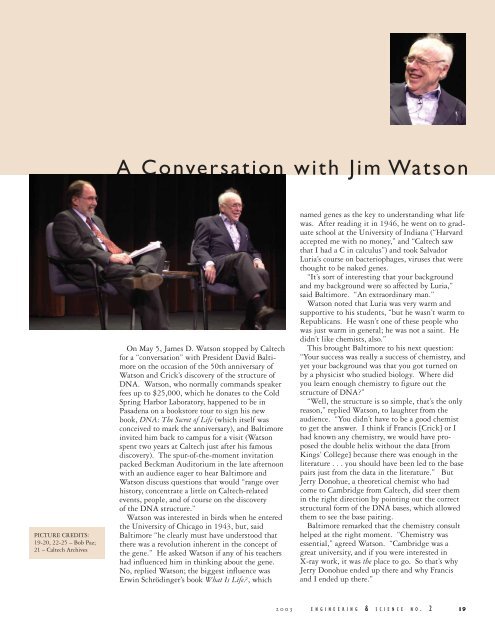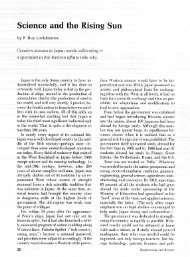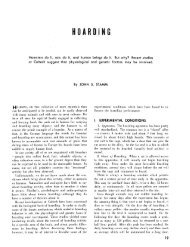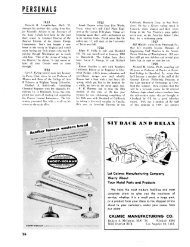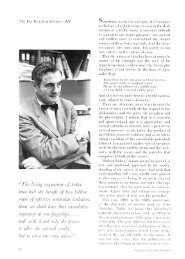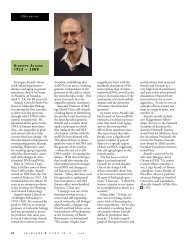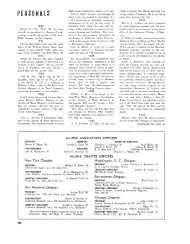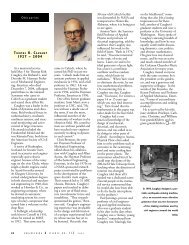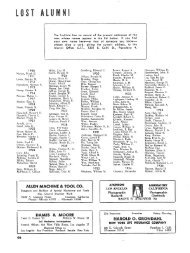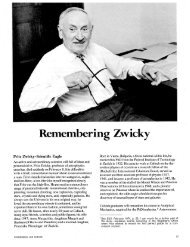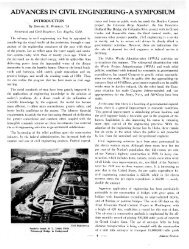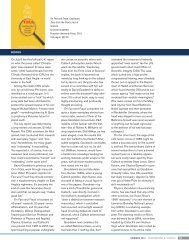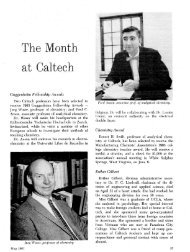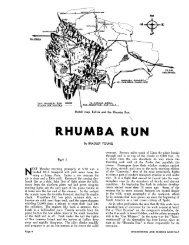A Conversation with Jim Watson - Engineering & Science - Caltech
A Conversation with Jim Watson - Engineering & Science - Caltech
A Conversation with Jim Watson - Engineering & Science - Caltech
Create successful ePaper yourself
Turn your PDF publications into a flip-book with our unique Google optimized e-Paper software.
PICTURE CREDITS:<br />
19-20, 22-25 – Bob Paz;<br />
21 – <strong>Caltech</strong> Archives<br />
A <strong>Conversation</strong> <strong>with</strong> <strong>Jim</strong> <strong>Watson</strong><br />
On May 5, James D. <strong>Watson</strong> stopped by <strong>Caltech</strong><br />
for a “conversation” <strong>with</strong> President David Baltimore<br />
on the occasion of the 50th anniversary of<br />
<strong>Watson</strong> and Crick’s discovery of the structure of<br />
DNA. <strong>Watson</strong>, who normally commands speaker<br />
fees up to $25,000, which he donates to the Cold<br />
Spring Harbor Laboratory, happened to be in<br />
Pasadena on a bookstore tour to sign his new<br />
book, DNA: The Secret of Life (which itself was<br />
conceived to mark the anniversary), and Baltimore<br />
invited him back to campus for a visit (<strong>Watson</strong><br />
spent two years at <strong>Caltech</strong> just after his famous<br />
discovery). The spur-of-the-moment invitation<br />
packed Beckman Auditorium in the late afternoon<br />
<strong>with</strong> an audience eager to hear Baltimore and<br />
<strong>Watson</strong> discuss questions that would “range over<br />
history, concentrate a little on <strong>Caltech</strong>-related<br />
events, people, and of course on the discovery<br />
of the DNA structure.”<br />
<strong>Watson</strong> was interested in birds when he entered<br />
the University of Chicago in 1943, but, said<br />
Baltimore “he clearly must have understood that<br />
there was a revolution inherent in the concept of<br />
the gene.” He asked <strong>Watson</strong> if any of his teachers<br />
had influenced him in thinking about the gene.<br />
No, replied <strong>Watson</strong>; the biggest influence was<br />
Erwin Schrödinger’s book What Is Life?, which<br />
2003<br />
named genes as the key to understanding what life<br />
was. After reading it in 1946, he went on to graduate<br />
school at the University of Indiana (“Harvard<br />
accepted me <strong>with</strong> no money,” and “<strong>Caltech</strong> saw<br />
that I had a C in calculus”) and took Salvador<br />
Luria’s course on bacteriophages, viruses that were<br />
thought to be naked genes.<br />
“It’s sort of interesting that your background<br />
and my background were so affected by Luria,”<br />
said Baltimore. “An extraordinary man.”<br />
<strong>Watson</strong> noted that Luria was very warm and<br />
supportive to his students, “but he wasn’t warm to<br />
Republicans. He wasn’t one of these people who<br />
was just warm in general; he was not a saint. He<br />
didn’t like chemists, also.”<br />
This brought Baltimore to his next question:<br />
“Your success was really a success of chemistry, and<br />
yet your background was that you got turned on<br />
by a physicist who studied biology. Where did<br />
you learn enough chemistry to figure out the<br />
structure of DNA?”<br />
“Well, the structure is so simple, that’s the only<br />
reason,” replied <strong>Watson</strong>, to laughter from the<br />
audience. “You didn’t have to be a good chemist<br />
to get the answer. I think if Francis [Crick] or I<br />
had known any chemistry, we would have proposed<br />
the double helix <strong>with</strong>out the data [from<br />
Kings’ College] because there was enough in the<br />
literature . . . you should have been led to the base<br />
pairs just from the data in the literature.” But<br />
Jerry Donohue, a theoretical chemist who had<br />
come to Cambridge from <strong>Caltech</strong>, did steer them<br />
in the right direction by pointing out the correct<br />
structural form of the DNA bases, which allowed<br />
them to see the base pairing.<br />
Baltimore remarked that the chemistry consult<br />
helped at the right moment. “Chemistry was<br />
essential,” agreed <strong>Watson</strong>. “Cambridge was a<br />
great university, and if you were interested in<br />
X-ray work, it was the place to go. So that’s why<br />
Jerry Donohue ended up there and why Francis<br />
and I ended up there.”<br />
ENGINEERING & SCIENCE NO. 2<br />
19
Before going on stage, <strong>Watson</strong> reminisces <strong>with</strong> Linda<br />
Pauling Kamb, described in The Double Helix as Peter<br />
Pauling’s “beautiful blonde sister,” who he thought would<br />
“undoubtedly liven up the Cambridge scene” in 1952, if she<br />
were to visit; and Seymour Benzer, the Boswell Professor of<br />
Neuroscience, Emeritus, whom <strong>Watson</strong> credits as one of the<br />
few who immediately sensed the importance of the<br />
double helix structure.<br />
Baltimore mentioned the experiments by<br />
Oswald Avery: “One of the things I’ve always<br />
been curious about is why they didn’t have the<br />
impact that they might have. The genetics<br />
community, particularly around Luria and [Max]<br />
Delbrück, never seemed to appreciate that Avery<br />
—this is now 1944—and his colleagues had<br />
published a paper that quite clearly showed that<br />
as chemically pure DNA as you could get would<br />
transfer genetic characteristics. And yet the idea<br />
that DNA was the carrier of genetic information<br />
really didn’t take hold.”<br />
“I think it was just that everyone expected that<br />
proteins were going to be involved,” said <strong>Watson</strong>.<br />
“And also the covalent backbone—how the<br />
nucleotides were linked together—wasn’t established<br />
until ’51. It was the Avery result that was<br />
the stimulus for [Erwin] Chargaff to measure the<br />
relative concentrations of DNA’s four bases<br />
(adenine, guanine, thymine, and cytosine) and for<br />
Alex Todd to get his organic chemists to establish<br />
the covalent structure. But neither Luria nor<br />
Delbrück thought in terms of molecules.<br />
“Luria thought chemists were just people who<br />
made money,” <strong>Watson</strong> continued. “You know, the<br />
bright people were physicists and geneticists.”<br />
When the Hershey-Chase experiment in 1952<br />
showed that DNA is the genetic material of<br />
phages and that proteins do not transmit genetic<br />
information, many scientists became convinced of<br />
the importance of DNA. But, said <strong>Watson</strong>, “it<br />
didn’t convince Luria. It was very surprising that,<br />
when we found the base pairs and I wrote to both<br />
Luria and Delbrück, Delbrück was immensely<br />
excited. The moment he got the letter, he rushed<br />
to tell Linus [Pauling] what the answer was. But<br />
Salva was rather slow. He just didn’t think in<br />
terms of chemistry. It was a foreign way of thinking.”<br />
Before the Hershey-Chase experiment, <strong>Watson</strong><br />
had moved to Sir Lawrence Bragg’s Cavendish<br />
Laboratory at Cambridge University (after a<br />
frustrating postdoc year to learn biochemistry<br />
20 ENGINEERING & SCIENCE NO. 2 2003<br />
under Herman Kalckar in Copenhagen), and had<br />
begun to tackle the structure of DNA. And he<br />
was encountering some interesting people around<br />
the continent. “I heard Maurice Wilkins in<br />
Naples in May 1951,” <strong>Watson</strong> related. “As soon<br />
as that meeting was over, I went to Geneva, where<br />
I saw Jean Weigle, who had just come from<br />
<strong>Caltech</strong> to spend the summer there. And he told<br />
me of hearing Linus propose a clever structure for<br />
the polypeptide chain (the alpha helix). He said<br />
he didn’t know whether Linus was right. So when<br />
I got back to Copenhagen, I went to the library<br />
and found the Pauling papers and read them.<br />
Soon afterwards Lawrence Bragg had been invited<br />
to give a lecture in Copenhagen, and he came and<br />
talked about Perutz’s result <strong>with</strong> the message that<br />
Pauling was right. So by the time I got to Cambridge,<br />
I knew that Pauling had used modelbuilding<br />
to get the alpha helix. So my first question<br />
to Francis was: could we use the modelbuilding<br />
approach for DNA? And Francis said,<br />
why not? And then he wrote Maurice; would he<br />
come up? And so Maurice came up from London<br />
for a Sunday lunch and said he thought DNA was<br />
a helix and that it was multichained. And then he<br />
said that he was sort of being stopped from pursuing<br />
it because he and Rosalind Franklin didn’t<br />
get on. He said Rosalind would be giving a talk,<br />
and I went and heard the talk. But, not knowing<br />
crystallography, I confused ‘asymmetric unit’ <strong>with</strong><br />
‘unit cell,’ and so had the water content wrong by<br />
24. So we built a very dry model.”<br />
On April 25, 1953, <strong>Watson</strong> and Crick published<br />
their now-famous paper in Nature on the<br />
work that won them and Maurice Wilkins the<br />
Nobel Prize in 1962. In September 1953,<br />
<strong>Watson</strong> arrived at <strong>Caltech</strong> for a meeting that<br />
Pauling had organized on protein structure. He<br />
stayed on for two years, first on a postdoctoral<br />
fellowship <strong>with</strong> Delbrück; in the second year,<br />
George Beadle made him a senior research fellow<br />
in biology.
Baltimore noted that “the Meselson-Stahl experiment<br />
was, of course, done at <strong>Caltech</strong> in the<br />
late 1950s and is often considered to be the experiment<br />
that really proved that the DNA structure<br />
was correct.”<br />
<strong>Watson</strong> agreed. “I think it proved that its main<br />
implication was correct; that is, that the strands<br />
really come apart. And that was why everyone<br />
really got excited by the structure. It could have<br />
been pretty, but so what? But if the strands come<br />
apart, and you copy <strong>with</strong> A and T and G and C,<br />
then that was the important thing.” <strong>Watson</strong> and<br />
Crick had suggested in their 1953 paper that the<br />
strands of the helix unzipped, providing a mechanism<br />
for copying genetic information, but the<br />
Meselson-Stahl experiment proved it. “It really<br />
didn’t get the recognition it deserved,” said<br />
<strong>Watson</strong>. “It should have gotten the Nobel Prize.<br />
It was an unbelievably important experiment. It<br />
really was the one that made most people want to<br />
study DNA. Until then people thought it was<br />
interesting, might be right, but almost no one<br />
changed what they were doing or started thinking<br />
in terms of the double helix. Seymour Benzer and<br />
Sydney Brenner—they were the people who really<br />
sensed the importance—and George Gamow. But<br />
in Cambridge—now it seems impossible to<br />
imagine—we had this structure, we sent the<br />
manuscript off in April, and no one asked us<br />
to give a seminar.”<br />
Baltimore asked <strong>Watson</strong> whether he gave a<br />
seminar at <strong>Caltech</strong> when he came here the following<br />
September. Yes, said <strong>Watson</strong>, about six weeks<br />
after arriving, and he had also given a talk at a<br />
Cold Spring Harbor symposium in June.<br />
After his two years at <strong>Caltech</strong>, <strong>Watson</strong> left for<br />
Harvard, and in 1968 became director of the Cold<br />
Spring Harbor Laboratory, in New York. “You<br />
moved to Cold Spring Harbor,” said Baltimore,<br />
2003<br />
“But in Cambridge—now it seems impossible to<br />
imagine—we had this structure, we sent the<br />
manuscript off in April, and no one asked us to<br />
“and I remember it was <strong>with</strong> a very clear idea<br />
of changing the direction of molecular biology<br />
toward mammalian biology and toward cancer.<br />
That was before recombinant DNA methods were<br />
available. It was before Howard Temin and I<br />
found reverse transcriptase. What did you think<br />
we were ready for at that time? Where did you see<br />
us going?”<br />
<strong>Watson</strong> had been interested in SV40 polyoma<br />
virus, a small cancer-producing DNA virus, which<br />
appealed to him because it had a very small<br />
number of genes and he thought he might find<br />
mutants. But he conceded, in retrospect, that they<br />
would have gotten nowhere <strong>with</strong>out recombinant<br />
DNA, the techniques for which weren’t perfected<br />
until the early ’70s.<br />
“I remember your telling me about polyoma<br />
when I once drove you from Cold Spring Harbor<br />
into Manhattan,” said Baltimore. “This was about<br />
Linus Pauling’s protein structure conference in September 1953 brought <strong>Jim</strong> <strong>Watson</strong> to <strong>Caltech</strong>, where he stayed for two years. Pauling stands third from left<br />
in the front row, <strong>with</strong> <strong>Watson</strong> directly behind him. Also in the photo are Maurice Wilkins (second row, far left) and Francis Crick (second row, fifth from left),<br />
who would share the Nobel <strong>with</strong> <strong>Watson</strong> in 1962; and John Kendrew (first row, far left) and Max Perutz (third row, second from left, next to <strong>Watson</strong>) who<br />
would share the Nobel Prize in chemistry, also in 1962. Sir Lawrence Bragg, director of the Cavendish, stands front row, center, in the white jacket.<br />
ENGINEERING & SCIENCE NO. 2<br />
give a seminar.”<br />
21
“To put together a<br />
thousand [genes], you<br />
needed God, but <strong>with</strong><br />
no God, you can say at<br />
some time it had to<br />
be simple.”<br />
1959. And you thought that there might be one<br />
gene in there that caused cancer. Have you been<br />
surprised at how difficult it has been to find the<br />
genes that cause cancer?”<br />
<strong>Watson</strong> replied, “Well, now we’ll find them all,<br />
but it’s a good rule that everything is five times<br />
harder than you think. When I spoke at the dedication<br />
of your new cancer center [at MIT], I said,<br />
‘You know, you guys are doing a wonderful thing:<br />
you’re siting cancer research in a place where<br />
you’re doing real science and you’re not trying to<br />
cure people. And then my talk got in the papers<br />
as ‘War on Cancer Big Failure.’ But what I said<br />
was that MIT was the only pure scientific place<br />
that had established a cancer center. It was left<br />
to clinical places to do it, and the clinical places<br />
weren’t as good as MIT. It was a place where you<br />
brought real brains to bear on cancer. <strong>Caltech</strong><br />
didn’t have the sense to do it.”<br />
“No comment,” said Baltimore. “But there’s<br />
certainly truth in that. So, now cancer research<br />
has moved forward for 40 years since those days,”<br />
he continued. “Do you think that we now have<br />
enough basic science so that we can concentrate<br />
more on the applications of the science to the<br />
human problem of cancer?”<br />
“You know,” replied <strong>Watson</strong>, “I may be a little<br />
nutty, but I actually believe that Judah Folkman’s<br />
ideas on antiangiogenesis [limiting the blood<br />
supply to tumors] will work. His antiangiogenic<br />
protein fragments, angiostatin and endostatin,<br />
certainly work in mice. So, if these proteins are<br />
normal regulators of cancer-cell growth, and if we<br />
went at it like the Manhattan Project, we could<br />
stop cancer in 10 years. But Judah, unfairly, is<br />
just thought of as a surgeon; he’s not a molecular<br />
biologist, so he’s pretty much ignored.” <strong>Watson</strong><br />
offered to bet Baltimore (“as much money as you’ll<br />
bet against me—even odds”) that Folkman would<br />
turn out to be right.<br />
“So in a sense, you’re saying you think we do<br />
have enough basic information,” said Baltimore.<br />
22 ENGINEERING & SCIENCE NO. 2 2003<br />
<strong>Watson</strong>’s indirect answer to that was: “If I were<br />
a young person, I wouldn’t do cancer research.”<br />
“What would you do?” asked Baltimore.<br />
“Well, the brain. It’s obvious. That’s a nobrainer.”<br />
“How about computational biology and all of<br />
the multiple integration methods?”<br />
“Well, you know,” replied <strong>Watson</strong>, “you can do<br />
systems biology and prove that a cell works.”<br />
“But you’re comfortable knowing it works<br />
already,” Baltimore assumed.<br />
“Yeah,” said <strong>Watson</strong>. “We already know how it<br />
works. So all the sort of equations proving that it<br />
works just monumentally bore me.”<br />
<strong>Watson</strong> went on to describe research that had<br />
determined that the bacterium B. subtilis has only<br />
about 250 genes essential to life. He said that in<br />
1965 he had thought of a bacterial cell as a little<br />
machine and tried to figure out how many essential<br />
parts there were. He had guessed there would<br />
be about a thousand parts, or genes. The astounding<br />
fact that a bacterium can have as few as<br />
250 necessary genes made sense, he thought,<br />
because “life had to get started. To put together a<br />
thousand, you needed God, but <strong>with</strong> no God, you<br />
can say at some time it had to be simple.”<br />
The tiny bacterial genome led Baltimore to his<br />
next question: What did <strong>Watson</strong> think was the<br />
most important result to come from the Human<br />
Genome Project? [From 1989 to 1992, <strong>Watson</strong><br />
was the first director of the National Center for<br />
Human Genome Research.]<br />
<strong>Watson</strong> answered, “The linking of genes and<br />
behavior,” pointing in particular to studies on a<br />
potential gene for violence. In a study in the<br />
Netherlands, it was found that a gene for the<br />
enzyme monoamine oxidase, which destroys<br />
neurotransmitters, was inactive in violent males<br />
in one family. Subsequent research discovered a<br />
weak promoter and a strong promoter for the<br />
gene, he explained. A study of youths in New<br />
Zealand <strong>with</strong> a history of violence found that they
largely carried the weak promoter. Young people<br />
<strong>with</strong> the strong promoter, however, even those<br />
from violent, abusive homes, were unlikely to be<br />
aggressive.<br />
Baltimore then asked: “What is the biggest<br />
ethical challenge that comes out of the kind of<br />
knowledge we’re developing today?”<br />
“I think it’s that we’re not using this knowledge,”<br />
said <strong>Watson</strong>. He pointed out that the gene<br />
for fragile X, which causes the most common form<br />
of inherited mental retardation (one in 265 women<br />
carries the gene), is known, but no one is being<br />
screened for it. “To me, the ethical thing is we’re<br />
being held back.”<br />
Baltimore: “Who’s holding that back? Why is<br />
it being held back? Is it because of lack of commercial<br />
interest?”<br />
“I think people are afraid to attack the Right to<br />
Life lobby, that’s all.” <strong>Watson</strong> responded. “Screening<br />
is bad. Screening is Hitler.”<br />
But, countered Baltimore, genetic screening “is<br />
an opportunity for each individual to decide on for<br />
himself or herself.”<br />
<strong>Watson</strong>’s response was that he finds it troubling<br />
that our society is indifferent to continued genetic<br />
disease. “There is a conflict between truth by<br />
revelation and truth by observation and experiment.<br />
I think the big fight eventually in our<br />
country is not going to be between Republicans<br />
and Democrats, but between those who think secularly<br />
and those who think in a fundamentalist way.”<br />
The audience applauded. “You know which side<br />
<strong>Caltech</strong> is on,” said Baltimore.<br />
“There are many people who believe in religion<br />
but don’t want to restrict other people,” continued<br />
<strong>Watson</strong>. “But fundamentalists want all people to<br />
follow their beliefs. People have had their lives<br />
totally set back by genetic disease, and I feel very<br />
strongly that we’re failing ethically by not using<br />
the knowledge that we have.”<br />
Baltimore observed admiringly that <strong>Watson</strong> had<br />
turned his question around, whereupon <strong>Watson</strong><br />
2003<br />
“There is a conflict<br />
between truth by<br />
revelation and truth by<br />
observation and<br />
experiment.”<br />
quickly responded, to audience laughter: “You<br />
have less ability than I to say what you think.”<br />
After acknowledging that there was “truth in<br />
that,” Baltimore changed the subject. He noted<br />
that 75 percent or more of the human genome is<br />
repetitive DNA. “There’s a fish, the fugu, that has<br />
very little repetitive DNA, and it does, in its fishy<br />
way, live perfectly well. It has roughly the same<br />
number of genes as we have. Do you think,” he<br />
asked, “that’s a proof that all of that excess DNA<br />
really is junk, sort of a parasitic DNA that only<br />
cares about itself?”<br />
“It’s more like 95 percent,” answered <strong>Watson</strong>.<br />
“As in the other species, it looks like there’s about<br />
5 percent that’s conserved—1 percent are aminoacid-specifying,<br />
and the other 4 percent are useful<br />
in regulating when, where, and to what extent<br />
individual genes function.” All human genetic<br />
variation resides in that 5 percent, he said, and he<br />
quoted Sydney Brenner’s opinion that you would<br />
need to study only 30,000 humans to track it all<br />
down. “While many human attributes won’t have<br />
genetic causes, we shall probably be surprised by<br />
the extent that they do.”<br />
Baltimore then brought up the Asilomar<br />
conference. “You and I have had very different<br />
opinions about the Asilomar conference,” he<br />
noted. “We gathered together a group of people<br />
there [Asilomar is a conference center on the<br />
California coast near Monterey] in 1975 to consider<br />
whether recombinant DNA experiments<br />
should go forward untrammeled or should be<br />
developed in some orderly [i.e., regulated] fashion,<br />
because of the potential danger that recombinant<br />
DNA experiments might have. I must admit that<br />
they haven’t shown any danger as time has gone<br />
along. I thought, and I still think, that that was a<br />
healthy process, even though nothing came out of<br />
it, but I know you feel differently.”<br />
<strong>Watson</strong> thought at the time that any regulation<br />
was capricious. He remembered that “Joshua<br />
Lederberg got up at the meeting and said, essen-<br />
ENGINEERING & SCIENCE NO. 2<br />
23
“If we could make mice<br />
more resistant to<br />
cancer, why wouldn’t<br />
you want to have<br />
humans who were<br />
enhanced not to have<br />
so much cancer?”<br />
tially, that if you regulate, people are going to<br />
think it’s dangerous. And boy, he was right.”<br />
“There was no question that people overreacted,”<br />
Baltimore conceded.<br />
“You don’t have traffic lights until there’s an<br />
accident,” added <strong>Watson</strong>. “Because so many<br />
things can go wrong. I really upset some people<br />
about genetically modified food. I said I thought<br />
they should instead worry about bicycles—worry<br />
about real things—because every time your kid<br />
gets on a bicycle, you don’t know what the hell is<br />
going to happen. . . . At Asilomar, the difference<br />
between sounding good and doing good was<br />
ignored. We certainly sounded good, but when<br />
Maxine [Singer] and Paul [Berg] had that press<br />
conference and made the comparison to nuclear<br />
energy, I thought oh boy, we’re in deep shit. We<br />
were.”<br />
“Well, we came out of it okay,” admitted<br />
Baltimore. To which <strong>Watson</strong> responded, “We got<br />
out of it, but just by the skin of our teeth.”<br />
Baltimore: “Now we’re into stem cells and<br />
cloning and genetic engineering, and I don’t know<br />
what the next controversy will be. Biology simply<br />
is headline controversy these days. How bad do<br />
you think that is for the field?”<br />
In his reply, <strong>Watson</strong> stated that he firmly<br />
believes that modern biology is beginning to<br />
profoundly affect how we as human beings live<br />
and think about ourselves. “You and I and all of<br />
our fellow scientists have to spend much more<br />
time <strong>with</strong> the public and do it over and over.<br />
We’re finding out what human beings are, and<br />
most people don’t think like us.” He would like<br />
to see scientists run for Congress and become part<br />
of the government. “You’ve got to get in there.<br />
The Christian Right—they’re in there. And we’re not.”<br />
A question period followed <strong>with</strong> written<br />
questions submitted by members of the audience.<br />
Many of <strong>Watson</strong>’s candid answers to these, as<br />
well as to Baltimore’s questions, were prefaced<br />
by “I probably shouldn’t say this” or<br />
24 ENGINEERING & SCIENCE NO. 2 2003<br />
“You and I and all of our fellow scientists have to<br />
spend much more time <strong>with</strong> the public and do it<br />
over and over.”<br />
“this will sound bad but it’s probably true.”<br />
To a question as to why DNA is the only selfreplicating<br />
biological code on Earth and what<br />
makes it so special compared to other selfreplicating<br />
molecules that might be out there,<br />
<strong>Watson</strong> replied that “that’s the sort of open-ended<br />
question for a chemist.” Biologists, he said, were<br />
only interested in things that exist. Baltimore<br />
then put the question another way: “What if we<br />
found another whole start to life on Mars and there<br />
were at one time on Mars living organisms of a<br />
different origin than the origin in Earth?”<br />
“It would be very interesting,” answered<br />
<strong>Watson</strong>. “I would want to study it. I would be<br />
very excited.”<br />
One audience member asked, “Do you think<br />
genetically enhancing humans as opposed to just<br />
curing disease is reasonable?”<br />
“If we could make mice more resistant to<br />
cancer,” <strong>Watson</strong> answered, “why wouldn’t you<br />
want to have humans who were enhanced not to<br />
have so much cancer? I think it’s human nature<br />
to want to improve things. As someone of considerable<br />
Irish heritage, I can speak for this group.<br />
The Irish need improvement. . . . You know, when<br />
you say it this way, hell, we’ve all got a long way<br />
to go.”<br />
Asked what he thought were the prospects for<br />
treating human aging, <strong>Watson</strong> said he found<br />
Cynthia Kenyon’s work exciting [Kenyon, at UC<br />
San Francisco, knocked out a gene in C. elegans<br />
that controls the aging process; the worms’ longevity<br />
doubled and they remained healthy and<br />
active]. But <strong>Watson</strong>, 75, allowed that old people<br />
don’t help society much. “Except for grandmothers,”<br />
he added.<br />
“But you’re still writing books,” said Baltimore,<br />
and then asked if <strong>Watson</strong> thought we would be<br />
using artificial means to increase longevity.<br />
<strong>Watson</strong>: “Look. You don’t want to die. I don’t<br />
want to die. Spending money to increase our life<br />
span is human.”
The <strong>Watson</strong>/Baltimore<br />
conversation can be<br />
viewed at http://<br />
atcaltech.caltech.edu/<br />
theater/.<br />
<strong>Watson</strong>’s earlier discussion of a possible genetic<br />
basis for criminal behavior provoked a question on<br />
whether this would have a tremendous impact on<br />
criminal law.<br />
He agreed that it was a complicated problem<br />
and noted that humans aren’t that different from<br />
chimps, who are born to kill—or from lions either.<br />
<strong>Watson</strong> said that he had been meaning to test<br />
himself on the suspicion that he might have “a<br />
low amount of the violence-promoting gene,” but<br />
added that he had good parents and that nurture is<br />
immensely important. “That’s why biology really<br />
is becoming so relevant. We have laws based on<br />
the fact that we’re equal. And we’re probably not<br />
going to be.”<br />
“So it is a big issue, having law that reflects the<br />
standards of genetics,” commented Baltimore.<br />
<strong>Watson</strong>: “And no easy solution.”<br />
The next question— “Were you genetically<br />
disposed to solve the structure of DNA?”—<br />
prompted laughter from the audience and an<br />
oblique answer from <strong>Watson</strong>: “Well, probably. I<br />
think curiosity is part of human nature, and I like<br />
facts more than most people.” <strong>Watson</strong> went on to<br />
complain that too many of his former students<br />
lacked curiosity.<br />
Then Baltimore read the kicker to the question:<br />
“And if so, should you feel proud of your achievement?”<br />
“Yeah, sure,” said <strong>Watson</strong>, to more laughter.<br />
“Shouldn’t John McEnroe feel good when he wins<br />
Wimbledon? Not everyone genetically programmed<br />
would be as good an athlete as he is.”<br />
Another question returned to the discovery of<br />
the double helix: “Do you think Rosalind Franklin<br />
would have shared the Nobel Prize <strong>with</strong> you<br />
and Francis, rather than Maurice Wilkins, if she<br />
had lived?”<br />
<strong>Watson</strong> didn’t answer directly, but noted that if<br />
they had given the double helix two Nobel Prizes,<br />
one in biology to <strong>Watson</strong> and Crick and one in<br />
chemistry to Wilkins and Franklin, “it would have<br />
been the nice thing.” But the fact remains that it<br />
was Crick and <strong>Watson</strong> who had the insight. “It<br />
was very embarrassing to call Maurice up and say<br />
we’ve solved your problem. We didn’t expect to<br />
get anything that big. We did use their data. It<br />
could have been done <strong>with</strong>out the data, but we<br />
used their data.”<br />
But Franklin, he insisted, “made some wrong<br />
choices. She should have solved the structure early<br />
in 1952,” but because she wasn’t interested in<br />
building models and refused to accept the idea of a<br />
helix, she missed the significance of her X-ray<br />
picture—but <strong>Watson</strong> and Crick did not. He said<br />
that he originally wanted to call The Double Helix,<br />
his 1968 account of the discovery, Honest <strong>Jim</strong>,<br />
“because it raised the question: did we behave<br />
correctly? At that time we didn’t even think<br />
about Rosalind; she was just holding things up.<br />
The person we wanted to beat was Linus.<br />
“The English couldn’t fail twice, so we had to<br />
2003<br />
win. Bragg would have been very disappointed,”<br />
he said, referring to the ongoing competition<br />
between Bragg’s Cavendish Laboratory and<br />
Pauling’s group at <strong>Caltech</strong>.<br />
<strong>Watson</strong> added that he was struck by the 18thcentury<br />
Scottish philosopher David Hume’s belief<br />
that humans are fueled by their passions, not by<br />
reason. “And Rosalind had a passion against<br />
helices, which overcame her reasoning.” But<br />
Franklin wasn’t alone in irrationality. <strong>Watson</strong><br />
admitted, “I didn’t want to use Chargaff’s data.<br />
He was so unpleasant that I didn’t want to use his<br />
data. That was passion. It had nothing to do <strong>with</strong><br />
reason.”<br />
To a question about whether genetic engineering<br />
could be dangerous in the hands of terrorists<br />
eager to create bioweapons, <strong>Watson</strong> replied that<br />
terrorists don’t really need it. If he were a terrorist,<br />
he said, he would use ordinary anthrax. “I<br />
worry about what exists.”<br />
“If you could change current science policy in<br />
the United States, what would you change?” In<br />
answer to this final question, <strong>Watson</strong> said he<br />
would give some government money to institutions<br />
to use at their discretion to “change this<br />
terrible situation where you can’t get a grant till<br />
you’re 35.” This surprised Baltimore, who said:<br />
“You and I and lots of other people have spent<br />
years and years trying to educate the Congress not<br />
to give money to institutions, but rather to give it<br />
to individuals. I don’t disagree <strong>with</strong> you that the<br />
perspective has changed, but it is a sea change to<br />
suggest that we now should give money to<br />
institutions.”<br />
Although <strong>Caltech</strong>’s initial greatness came<br />
from foundation money to the institution, things<br />
changed after World War II and the rise of government<br />
funding of science. “Forty years ago,<br />
there were relatively few people who ran science<br />
and determined its policy,” said <strong>Watson</strong>. “And so<br />
the president of <strong>Caltech</strong> 40 years ago was far more<br />
important than you are today, relatively.” (The<br />
audience, and Baltimore, laughed.) “Then there<br />
were only a few places that the country counted on<br />
to do it.”<br />
“Are you in a sense suggesting that science has<br />
gotten too big?” Baltimore asked. “There’s too<br />
much? And so it’s diluting quality or diluting<br />
good sense?”<br />
No, answered <strong>Watson</strong>. “Understanding human<br />
beings at the molecular level—understanding the<br />
immune response, which is a lot more complicated<br />
than was thought 30 years ago, and the brain—<br />
will take an awful lot of people.” He expressed<br />
confidence that scientists will make enormous<br />
advances in understanding the brain over the next<br />
50 years.<br />
Baltimore decided it was time to give his guest<br />
some respite before his next appearance that<br />
evening at Vroman’s Bookstore. The audience<br />
thanked him for his <strong>Caltech</strong> visit <strong>with</strong> long and<br />
loud applause. ■ —JD<br />
ENGINEERING & SCIENCE NO. 2<br />
25


